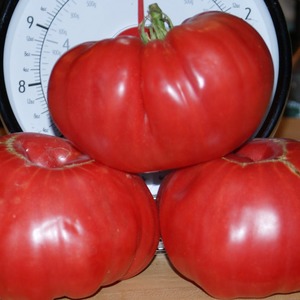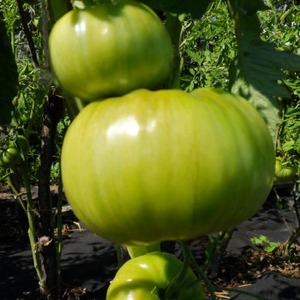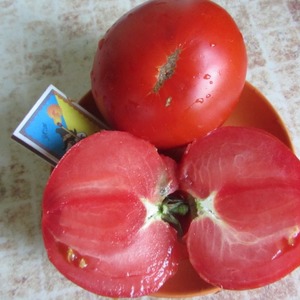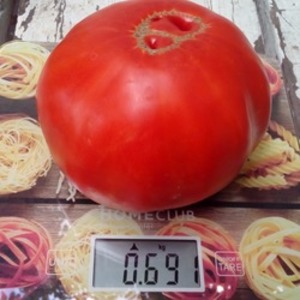Fleshy and sweet fruits to your table - tomato "Sugar pudovichok": characteristics and description of the variety
The name Sugar Pudovichok itself attracts attention. Immediately I want to know as much as possible about this variety. What is the origin of this name? Of course, because of the sweet fruits of impressive size. A ripe tomato weighs 250-400 g, and when cut is sugared at the break.
With proper agricultural technology, fruits weighing up to 600 g are obtained, which can replace any sweet fruit. In short, this tomato is a real find for those with a sweet tooth.
The content of the article
Characteristics and description of the variety
Varietal culture was developed in the 90s by Novosibirsk breeders of the Siberian Garden agrofirm. It is intended for breeding even in the most severe climatic regions. It was entered into the State Register in 1999.
Distinctive features
Bush indeterminate, with a height of 80 cm in the open field, in a greenhouse reaches 1.5 m. The stem is powerful, therefore, it requires compulsory garter and pinching. The foliage is medium, the leaves are dark green. Each seedling forms 5-6 fruitful clusters, each cluster sets 5-6 fruits.
Mid-season species, from the moment of sowing to full maturation, 115-120 days pass.
The yield is high, from 1 sq. m, 6-7 kg of fruits are harvested, planting no more than 4 seedlings per 1 sq. m.
Disease resistance is weak. The variety is susceptible to diseases such as late blight, tobacco mosaic and brown spot. For this reason, it is necessary to disinfect the soil before planting and carry out regular preventive measures.
The tomato is well adapted to temperature extremes and unfavorable conditions.
Fruit characteristics
The average weight of a tomato is 250-350 g. The shape is rounded, slightly flattened upwards, the color is pink-red, saturated. The taste is sweet with a slight sourness characteristic of tomatoes. The pulp is dense, juicy, few seeds.
 The rind is firm enough to withstand long distance transportation. During transportation, tomatoes are placed in boxes in 2 or 3 layers.
The rind is firm enough to withstand long distance transportation. During transportation, tomatoes are placed in boxes in 2 or 3 layers.
Ripe vegetables are equally suitable for fresh cooking and for winter preparations. When processed for tomato products, they produce excellent juices, pasta, ketchup, adjika and sauces.
The photo shows the tomatoes Sugar pudovichok.
How to grow seedlings
Seeds for seedlings are sown 65-70 days before planting in the ground. The final sowing dates determine the climatic characteristics of the region.
Seed preparation
Proper seed preparation is essential for healthy seedling growth. Since it is not a hybrid, the seed can be harvested by yourself. Preparation consists in the selection of quality seeds, disinfection and improvement of germination.
First, the seeds are determined for internal filling by submerging in saline for 10 minutes. A solution is prepared from 1 teaspoon of salt and 1 glass of water. Empty grains will float to the surface. Disinfection consists in processing with a solution of potassium permanganate. For 20 minutes, the seeds are immersed in a pink solution to disinfect the seeds. After the procedure, they are thoroughly washed and dried.
To improve germination, the seed is left in a growth stimulator for 10 hours. A special preparation "Zircon" or melt water is used as a stimulant.
reference... Melt water is obtained from snow, which is heated to room temperature.
Swollen seeds are ready for sowing.
Capacity and soil
The soil is prepared from garden soil and humus in equal proportions. Washed river sand is added as a baking powder. All components are thoroughly mixed and steamed in an oven at 60 ° C for 10 minutes or spilled with a hot solution of dark potassium permanganate.
reference... Disinfection of the soil when planting crops with weak immunity is required.
The disinfected soil is laid out in planting containers, having previously made drainage holes at the bottom of each of them. In the absence of drainage holes, the accumulation of excess moisture can destroy the root system.
They are planted in a common wooden box or separate paper honeycombs, plastic and peat cups. Any landing container before planting is treated with a manganese solution.
Sowing
The seed is sown into 1 cm deep grooves at a distance of 2 cm from each other. Sprinkle on top with peat, slightly compact, watered with warm, settled water using a spray bottle and covered with a film. The containers are left in a warm room at a temperature of 24 ° C until the first shoots appear.
Seedling care
As soon as the first shoots appear, the film is removed and the containers are rearranged on the windowsill. Seedlings need sufficient light, otherwise the seedlings will begin to stretch and weaken. Daylight hours should be at least 13 hours. If there is a lack of natural light, they are supplemented with fluorescent lamps. Additional lighting should be taken care of in advance, especially in regions with short daylight hours.
Water the seedlings with moderately warm, settled water using a tablespoon. Waterlogging of the soil increases the risk of a dangerous fungal disease, blackleg. The black leg is capable of ruining all plantings in the shortest possible time.
reference... Black leg is a collective popular name for many tomato diseases with common features: blackening and decay of the lower part of the stem.
Seedlings dive after the appearance of 2 true leaves, seating them in separate containers. When picking, only strong and healthy plants are left for further development.
If the bushes do not grow well, they are fed with liquid fertilizer for tomato seedlings. Top dressing is combined with the next watering.
After watering, the soil is loosened, ensuring the air permeability of the soil.
2 weeks before transplanting into the ground, the seedlings are hardened by taking them outside in the daytime at a temperature of 17 ° C. Initially, the seedlings are left in the open air for 1 hour, gradually this time interval is increased to 12 hours.
How to grow tomatoes
Seedlings are transplanted into the soil after it warms up to 16 ° C. By this time, the bushes have a fully developed root system that can quickly adapt to new conditions.
Landing
For 1 sq. m place no more than 4 seedlings in a checkerboard pattern. This planting method ensures that each plant receives the required amount of sunlight. In addition, the bushes will be ventilated unhindered, which prevents the development of fungal infections.
The soil is prepared 2 weeks before planting, digging with the addition of wood ash. Transplanted in the evening after sunset into shallow holes. The seedlings are set vertically and buried to the first leaves.
Further care
 Regular watering is established as soon as the seedlings take root in a new place. The average adaptation time is no more than 8 days. Watered with settled water under the root, without filling the holes. The culture accepts drip irrigation well. With such an irrigation system, waterlogging of the beds is impossible.
Regular watering is established as soon as the seedlings take root in a new place. The average adaptation time is no more than 8 days. Watered with settled water under the root, without filling the holes. The culture accepts drip irrigation well. With such an irrigation system, waterlogging of the beds is impossible.
After watering, the soil is loosened and hilled. This technique improves oxygen penetration to the roots, which is essential for healthy plant growth.
To keep the beds moist, they are mulched with straw, sawdust or dry leaves.Also, mulching serves as a preventive measure in pest control.
The culture is fed 4-5 times over the entire season, but the ideal option is to apply additional fertilizing once every 2 weeks. Fertilizer is a full range of minerals, which alternate with organic matter. During the flowering period, add boric acid, fertilizing with substances predominantly containing phosphorus, and during fruiting, the plants are fed with potassium fertilizers. From organic matter, an infusion of mullein is used at a dilution of 1:10.
Features of cultivation and possible difficulties
The culture needs mandatory formation, since this factor affects the quantitative indicator of fruiting. When dribbled in 2 stems, growers achieve maximum output. To do this, delete everything stepsons above the first flower race, leaving only one lower lateral process. At the time of fruit setting, those leaves that are below are removed.
When transplanting, a support is installed next to each seedling to tie the stem and fruit-bearing branches to it. The stem is fixed almost immediately, which has a beneficial effect on its formation. The main stem grows even and strong. Fruiting branches are fixed as they grow. Loose ones will not support the weight of ripe vegetables and will break.
Diseases and pests
The variety is not highly resistant to dangerous diseases and can become a victim of both fungal and viral diseases. Of the diseases with a fungal etiology, late blight is considered the most dangerous. When plants are damaged, it destroys up to 70% of all plantings. In order to prevent fungus from entering the beds, it is necessary to carry out prevention.
Observing the rules of crop rotation, gardeners strengthen the immunity of plants by planting them in those places where they will receive the greatest amount of nutrients. According to these rules, the tomato cannot be planted in the beds where potatoes, peppers or eggplants previously grew. These crops also belong to the nightshade family and are affected by the same diseases. After them, residues in the soil of pathogenic spores are possible, which will cause irreparable harm to the tomato crop.
Moderate watering with moisture control in the beds will prevent moisture from rising, thereby reducing the risk of fungal spores spreading.
In case of fungal infections, fungicidal agents are used, for example, "Fitosporin" or "HOM".
As for viral diseases, it is impossible to save the plants if they are damaged, so they are simply burned. Prevention consists in removing weeds from the roots. Once every 10 days, the bushes are watered with a weak solution of manganese and periodically sprayed with a milk solution. Milk solution is prepared from 100 ml of whey diluted in 1 liter of boiled water.
Of the pests, the greatest danger to tomato is spider mite and scoop... The scoop is a garden caterpillar that feeds on leaves, as a result of which the plant weakens and dies. The scoop also harms the fruit by eating them. As a result, they fall off before reaching ripeness. To combat it, eggshells are scattered in the aisles, which does not allow the scoop to get out of the ground. Sharp-smelling herbs - basil, cilantro - are planted next to the tomatoes. Their smells scare away caterpillars.
To get rid of a spider mite, it is enough to air closed structures daily. The spider mite is a greenhouse pest. The influx of fresh air destroys its usual habitat.
Nuances for open ground and greenhouses
The tomato is recommended for growing outdoors in the southern area and middle lane. In the harsh Siberian conditions, the culture is planted in greenhouses.
In greenhouses, plant growth reaches 1.5 m.
It is recommended to replace the top layer of soil in the greenhouse with a new one every year. This is due to the fact that disease-causing spores and many pests successfully overwinter in the ground, and in the spring, when planting crops, they are activated.A new soil layer must be spilled with a hot solution of potassium permanganate and treated with copper sulfate. The walls of protected structures are sprayed with Bordeaux liquid.
In regions with short and cool summers, additional lighting is installed in greenhouses for the full development of seedlings. With sufficient light, the stem does not stretch, forming strong and even.
In the open field, abundant watering negatively affects the taste of the fruit, making them watery. In addition, the fruit can crack.
Harvesting and application of the crop

After 3.5-4 months after sowing, they start harvestingI am. The fruits are harvested as they ripen, thereby unloading the bush for the next batch to ripen. Overripe fruits can crack.
The purpose in cooking is universal: tomatoes are ideal in fresh dishes and winter preparations. They are used to prepare salads, various snacks, slices, hot and vegetable dishes, and are added when baked with meat. Large sizes do not allow to prepare preserves as a whole, but when cut, they do not lose their taste at all, so they are salted and pickled not only individually, but also mixed with other varieties. Vegetables are processed to produce excellent juices, pastes, lecho, sauces, adjika and ketchup.
Ripe vegetables can be stored for a long time, observing the basic rules, namely, without stacking them in high rows on top of each other. The room in which tomatoes are stored must be dry and cool.
Advantages and disadvantages
Based on varietal characteristics and photo reviews, we list the advantages of the variety:
- the ability to adapt to adverse conditions;
- uncomplicated agricultural technology;
- high yield rate;
- great taste;
- large fruits;
- universal purpose;
- long transportation;
- the possibility of self-selection of seeds.
The main drawback of the culture is a weak immunity to dangerous diseases of the Solanaceae family. This also includes the necessary garter of plants and the regular removal of stepchildren.
Farmers reviews
Despite the shortcomings, reviews about the culture are positive. Here are some of the opinions of gardeners:
Galina, Novokuznetsk: "Tomatoes are large, up to 600 g, tasty, fleshy, fragrant, with a small amount of seeds. But it was these seedlings that got sick first. The leaves turned brown and began to dry out. She did not wait, she took off the tomatoes unripe. The vegetables picked up their color perfectly on their own at room temperature. The taste was amazing. I would like to plant again because of the taste. "
Galina, Omsk: “Tomato variety I planted Sugar Pudovichok for the first time. The height reached 2 m. The yield is high, the immunity is strong - the plants did not hurt at all throughout the season. Tomatoes are large, tasty, sugar-cut. It was enough to eat in the summer and to twist for the winter. I am very pleased. I collected the seeds myself for planting next year. "
Conclusion
Even in spite of some shortcomings, the tomato variety Sugar Pudovichok won a universal vocation, firmly rooted in all regions of our country. A high-yielding species with large sweet fruits is loved by both adults and children.
The main plus of the culture is the ability to take root even in the most severe areas, completely not inferior in taste to those fruits that are grown in the south. Tomato has been famous for over 20 years and continues to attract new fans.